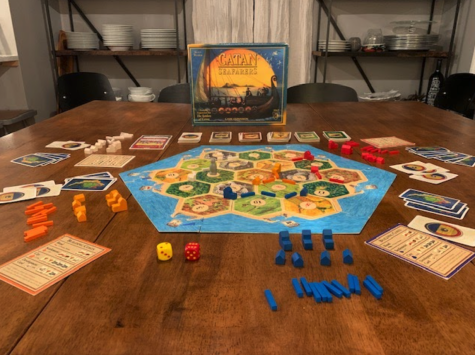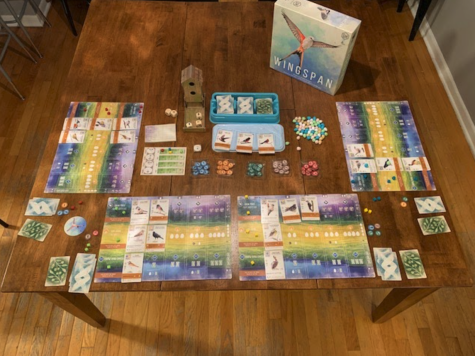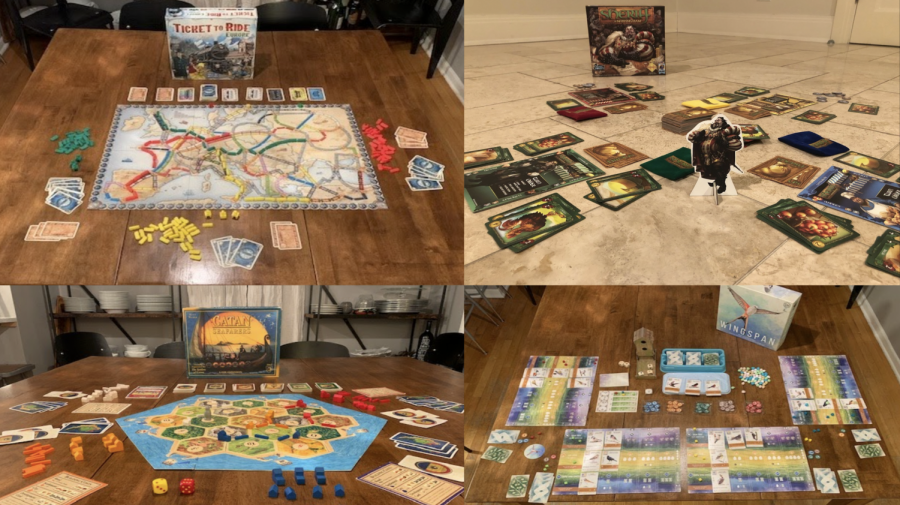Game Review: Settlers of Catan, Wingspan, Ticket to Ride, and Sheriff of Nottingham
Welcome to The Forum’s newest recurring column! Each issue you will see a review of three or more games. Some will be meant for family game night, others for parties, and others for competitive play. Hopefully, each edition of Game Review will inspire you to play one or more of them.
Each game will be given a difficulty rating, ranging from 0-5. Since almost everyone knows how to play Monopoly, it will be the reference point; Monopoly is a 1.

Note: The box in the background says Catan Seafarers. That is an extension of the base game Settlers of Catan
Settlers of Catan
Difficulty Level: 3
Play Time: 50-70 minutes
Number of Players: 2-4
Recommended Age: 11+
Settlers of Catan is one of the most rewarding games to learn. While the instructions may seem complicated, the game is simple. In this civilization-building game, players construct cities, settlements and roads to collect victory points. The game is played on a hex tile board which players can rearrange to create their own maps. Each tile can provide a different resource: wool, ore, brick, wood, and wheat.
On each turn, a player will roll the dice to determine which resources should be distributed from which tiles. Then, they can buy special buildings or Development Cards, trade resources, and play Development Cards. Each of the buildings, settlements and cities provide one and two victory points, respectively. Development Cards provide special abilities that aid a player. Some give you Victory Points, others are Knights (used to ward off the Robber), and some let you build roads.
One critique I have is that if you are behind in the game, you will almost always lose. Consequently, if an opponent seems to be ahead of everyone else, then they will probably win. There are not a lot of opportunities for the underdog to catch up. While there is trading, the only way to actually stall your opponents from winning is to obstruct their construction of roads. Otherwise, you can move the Robber to block a player’s production of resources.
The Robber is a special piece that can move around the board during the game. Whenever a seven is rolled during the production phase, instead of resources being distributed, the active player instead moves the robber to any hex. Whichever hex that the robber is on cannot produce resources.
Settlers of Catan also has over five different expansions, each adding a new approach to the game. After learning how to play the basic game, you should get the Seafarers expansion set. It adds two new types of hexes to the board: water and gold mines. After that, if you are still looking for a more complex game, buy the Cities and Knights expansion set. It adds many new features to the base game, but the most notable are the Barbarians, the Production Flip-book, and the Production cards.
“I like the strategy involved in the game. There are many complicated decisions to make. There are many ways to play the game, so you’ll never play the same game twice. If I were to improve the game, I would make Development Cards less powerful. I would also rebalance the effectiveness of the Robber.”
—Gideon Heltzer (Sophomore)

Wingspan
Difficulty Level: 4
Play Time: 40-75 minutes
Number of Players: 1-5
Recommended Age: 13+
If you are looking for a game with smooth mechanics and equally magnificent art, then this is the one for you. In Wingspan, players compete to get the most points at the end of the game. During each player’s turn, they can either play a bird, gain food, lay eggs, or draw birds. There are three habitats in the game: Forest, Plains, and Water. The Forest lets you take the Gain Food action, the Plains lets you take the Lay Eggs action, and the Water lets you take the Draw Birds action.
The Play a Bird action does not have its own habitat—merely a row on your player board. Each bird you play requires an amount of food as well as an amount of eggs to be sacrificed depending on the amount of birds you have already played in that habitat. Each habitat can host different birds that will most likely comply with that habitat’s abilities. For example, the Forest habitat will host birds that give you food, Plains to lay eggs, and Water to draw birds. Some birds, such as the Ravens and the Hummingbirds, allow you to draw cards and give you food from the Plains habitat. This ability is incredibly powerful since it can allow you to be efficient with your turns. Keep in mind, you can only take one of the actions per turn.
As the game progresses, you will fill up your board with more and more birds. Each of the over 180 different bird cards feature a different ability. Whenever you take an action from one of your habitats, you can activate your birds. This creates a cascading effect through your habitat. More birds in each habitat give you better rewards.
The only downside to this game is that there is no player interaction. It is almost like each player is playing by themselves since they can’t change the way their opponents play. On the other hand, it is very easy to suddenly take the lead. Even if you are behind, you can still come back.
“My favorite thing about Wingspan is collecting and looking at all of the beautiful bird cards! It’s awesome how many different birds they are not only from an artistic sense, but also because it means you can plan many times and it’ll be different every time. (My other favorite thing is that I think it’s a great complexity level. Interesting enough for people that like board games, but not so complicated that you can’t teach it to someone else.)
Something I might change, although I’m not sure how, might be the scoring. Because there are so many bird cards and so many different ways to get points, the winning and losing can feel a bit too random at times. That doesn’t take away from the enjoyment for me, but I wonder if the scoring could be modified to make the winner a bit more strategic and less due to the whims of which birds you happen to play with.”
—Mx. Hansberry (Computer Science Department Head)
Note: This is Ticket to Ride: Europe. The original game is an American map instead of a European one.

Ticket to Ride
Difficulty Level: 2
Play Time: 50-90 minutes
Number of Players: 2-4
Recommended Age: 10+
Travel across the country by building trains and completing tickets. In the original game, the board is a map of the United States. However you can also buy other versions that feature other geographic regions.
The setup is easy. All you need to do is lay out the board, give each player a color, and place the train and ticket decks next to the board. Then, deal each player three tickets and five train cards. A player can then choose two or three of the tickets to keep.
On a turn, a player can draw train cards, play trains, or draw tickets. There are 12 different colors of train cards in the deck which can be used to complete routes and tracks. Between each city on a map, a number of tracks reach out to adjacent cities. For example, in the United States map, you can go from Chicago to Pittsburgh. Some tracks require you to play many trains to complete them, while other routes are small and easy to complete.
If at any time you have completed your starting tickets, you can draw new tickets. Sometimes this is risky, since your already completed tickets may not align with the routes on the ones you just drew.
At the end of the game, calculate the total value of your trains. Longer trains are worth more points. For example, a two-segment train gives you two points, while a four-segment train gives you seven. Finally, subtract the value of your unfinished tickets.
One thing to improve is the competition levels in the game. While playing, you keep your tickets secret so that only you can see them. This means that you never actually know your opponents’ total points, leading to an occasionally misguided decision. Overall, though, it is a very minor inconvenience.
“I enjoy how suddenly the leader board can change. Perhaps updating or releasing new maps could be fun.”
—Alec Branovacki (Freshman)

Sheriff of Nottingham
Difficulty Level: 2
Play Time: 20-50 minutes
Number of Players: 3-5
Recommended Age: 11+
Sheriff of Nottingham is a game of smuggling, deception, and betrayal. Legal goods, bread, apples, roosters, and cheese, are worth a small amount of gold. Illegal goods, such as pepper, guns, and mead, are worth larger sums of money.
The role of Sheriff rotates in a clockwise fashion among players. They attempt to sniff out lies and deception from other players. If they catch a player attempting to smuggle illegal goods, then they get to fine that player for the amount that the goods were worth. Thus, non-Sheriff players must try to lie or bargain with the Sheriff if they want to win.
In every round, each non-Sheriff player chooses up to five cards from their hand and secretly puts them into their bag. The Sheriff then questions each player as to what is in their bag. For example, a player could claim to have put three Cheese in. There are multiple outcomes for this situation:
The player was either telling the truth or lying and they were let through by the Sheriff:
The player puts their goods in the corresponding piles in front of them (to be counted at the end of the game).
The player was telling the truth but the Sheriff checked their bag:
The sheriff has to pay that player an amount of money equal to the total value of the cards.
The player was lying and the Sheriff checked their bag:
The player has to pay the Sheriff an amount of gold equal to the total value of the cards that were not supposed to be in the bag.
Winning the game is simple. All you need is to have the highest amount of money at the end of the game. Each good that you have at the end of the game gives you a certain amount of money. Evidently, illegal goods are worth more.
Players are also encouraged to make deals, and then to break them as well. This is a game of wits.
“I really like it because it can be cooperative, but you also have to be wary of everyone else. You don’t know when to trust and when to not.”
—Gideon Burnett (Sophomore)
Again, this will be a recurring column, so be on the lookout for some more reviews. There will be a large range of games in these articles, so don’t worry about not seeing anything that appeals to you right away.
Winston Spreitzer ('24) is delighted to be returning as a staff writer to The Forum this year. In the past, he has written articles about rock climbing,...





















































Gabriel Di Gennaro • Feb 3, 2022 at 11:11 am
YEEESSSS to Wingspan. Glad to see it mentioned here : )